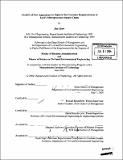Analysis of new approaches to improve the customer responsiveness of Intel's microprocessor supply chain
Author(s)
Chow, Jim, 1972-
DownloadFull printable version (12.63Mb)
Other Contributors
Leaders for Manufacturing Program.
Advisor
Donald Rosenfield and David Simchi-Levi.
Terms of use
Metadata
Show full item recordAbstract
Intel Corporation is looking to strengthen its long-term competitive armor by engaging in new initiatives to develop world-class customer service and build strong customer loyalty. A company's supply chain design and processes often hold the key to how well the company can serve its customers. This thesis looks to unlock new approaches for Intel to improve the customer responsiveness of its microprocessor supply chain. The primary approaches examined include (1) the identification and implementation of customer-focused supply chain metrics through a metrics framework and (2) the application of traditional inventory models and service level to determine optimal microprocessor inventory levels for Intel's die and finished goods inventories. The base stock inventory model is used along with extensions to the model based on work by Graban (1999) and Levesques (2004) that include two-stage inventory analysis along with supply variability inputs. The results of the inventory models are then compared with Intel's current inventory strategy based on heuristics. Next the application of the inventory models are extended to examine the possibility of setting service levels by product segment and the resulting impact on overall inventory mix and inventory levels. Finally, other approaches for improving the customer responsiveness of Intel's microprocessor supply chain are discussed at a high level as potential areas for future research. Many of the frameworks, learnings, and insights from the research done at Intel are transferable to other corporations which seek to make similar improvements to the customer responsiveness of their supply chains.
Description
Thesis (M.B.A.)--Massachusetts Institute of Technology, Sloan School of Management; and, (S.M.)--Massachusetts Institute of Technology, Dept. of Civil and Environmental Engineering; in conjunction with the Leaders for Manufacturing Program at MIT, 2004. Includes bibliographical references (p. 135-136).
Date issued
2004Department
Leaders for Manufacturing Program at MIT; Massachusetts Institute of Technology. Department of Civil and Environmental Engineering; Sloan School of ManagementPublisher
Massachusetts Institute of Technology
Keywords
Sloan School of Management., Civil and Environmental Engineering., Leaders for Manufacturing Program.